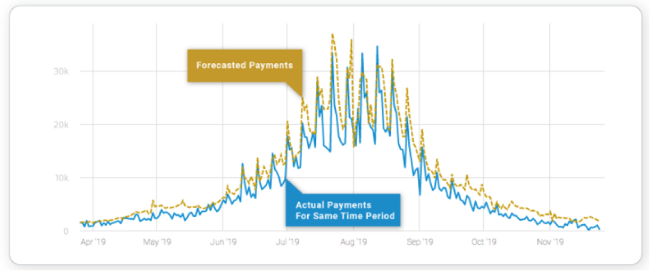By Rudrendu Kumar Paul and Bidyut Sarkar
Embracing the Future of Supply Chain Management: An Exploration of AI’s Transformative Impact on Demand Forecasting and its Potential to Navigate Global Uncertainties.
Source: Time Series Forecasting at Anodot
Takeaways:
- While useful in the past, traditional demand forecasting methods face limitations in today’s rapidly changing market environment.
- AI offers a more sophisticated approach to demand forecasting, capable of analyzing vast amounts of data and identifying complex patterns.
- AI-driven demand forecasting can lead to optimized inventory management, reduced waste, and increased profitability across various industries, including retail, life sciences/pharma, semiconductor, and fintech.
- Global uncertainties like the COVID-19 pandemic pose significant challenges to demand forecasting, but AI can be crucial in navigating these uncertainties.
- The future of demand forecasting in supply chain management is likely to be significantly influenced by the continued evolution and application of AI technologies.
In the dynamic world of supply chain management, demand forecasting is a critical component, a linchpin that can make or break the efficiency of operations. It’s a delicate dance, balancing the scales of supply and demand and one that has been traditionally fraught with challenges. The conventional methods of demand forecasting, while having served their purpose in the past, are increasingly showing their limitations in the face of a rapidly evolving market landscape. These methods, often reliant on simple statistical models and manual inputs, need help to accurately predict demand, leading to inefficiencies such as overstocking, understocking, and increased operational costs.
This article aims to delve into these challenges, exploring the shortcomings of traditional demand forecasting methods and setting the stage for a discussion on a more innovative, technology-driven approach. The focus will be on how artificial intelligence (AI) and machine learning can revolutionize this critical aspect of supply chain management.

Traditional time series-based demand forecasting models
Source: Forecasting in Operations Management
Challenges with Traditional Demand Forecasting
At its core, demand forecasting is an attempt to predict the future. Traditional methods have typically relied on historical sales data, using statistical models to extrapolate this data into the future. These models, such as time series analysis and causal models, have been the mainstay of demand forecasting for many years. However, these traditional methods come with their own set of limitations. They often assume that past patterns will continue, a presumption that can be misleading in a rapidly changing market environment. Additionally, these models need help incorporating external factors such as market trends, economic indicators, and unforeseen events, which can significantly impact demand.
These limitations pose significant challenges for supply chain management. Inaccurate demand forecasts can lead to overstocking or understocking, which have profound implications. Overstocking ties up capital in unsold inventory and increases storage costs, while understocking can lead to missed sales opportunities and damage customer relationships. Moreover, these challenges are not isolated incidents but can ripple effects throughout the supply chain. For instance, inaccurate demand forecasts can disrupt production schedules, leading to inefficiencies and increased costs. They can also impact supplier relationships, as unexpected changes in order volume can strain these partnerships.
In essence, the limitations of traditional demand forecasting methods can create a domino effect, leading to a cascade of challenges that can undermine the efficiency and profitability of supply chain operations. Against this backdrop, the potential of AI-driven demand forecasting begins to shine, offering a more robust and accurate approach to predicting future demand.
The Solution: AI-Driven Demand Forecasting
As the limitations of traditional demand forecasting methods become increasingly apparent, a new approach is emerging, one that leverages the power of artificial intelligence and machine learning. These technologies have revolutionized numerous fields and are now poised to transform demand forecasting.
Artificial intelligence, particularly machine learning, brings a new level of sophistication to demand forecasting. Unlike traditional methods, which often rely on simplistic assumptions, machine learning algorithms can analyze vast amounts of historical data, identify complex patterns, and learn from these patterns to make accurate predictions about future demand. Furthermore, these algorithms can incorporate various external factors, from market trends to economic indicators, providing a more comprehensive view of demand.
From a technical perspective, common machine learning models used for demand forecasting include time series models like regression and deep learning models like recurrent neural networks (RNN) and long short-term memory networks (LSTM). These models are trained on historical sales data and engineered features capturing demand drivers like promotions, prices, seasonality, and external factors. The models undergo rigorous validation and testing before being deployed into production systems that generate forecasts and connect to ordering and inventory planning engines.
Monitoring, retraining, and model improvement are critical to maintaining forecast accuracy over time. Challenges around data quality, concept drift, and model degradation need to be managed. But with the right ML architecture, pipeline, and infrastructure, AI-driven demand forecasting can deliver significant value.
The benefits of this AI-driven approach are manifold. By providing more accurate demand forecasts, AI can help optimize inventory management, ensuring that the right amount of stock is held at the right time. This can reduce waste from overstocking and prevent missed sales opportunities from understocking. Moreover, by improving the accuracy of demand forecasts, AI can help streamline production schedules and improve supplier relationships, leading to increased operational efficiency and profitability.
In short, AI-driven demand forecasting represents a significant step forward in supply chain management. By harnessing the power of artificial intelligence and machine learning, businesses can overcome the limitations of traditional methods and navigate the complexities of demand forecasting with greater accuracy and efficiency.
Applications and Case Studies Across Multiple Industries
Retail Industry
Consider the case of a prominent online retailer that implemented AI-driven demand forecasting. The retailer, faced with various products and fluctuating demand, turned to machine learning algorithms to analyze historical sales data and market trends. The result significantly improved forecast accuracy, leading to optimized inventory levels, reduced storage costs, and increased sales due to better product availability.

Source: Pharmaceutical Technology
Life Sciences/Pharma Industry
In the life sciences and pharma industry, AI-driven demand forecasting has shown promise in managing the supply of active components. A leading pharmaceutical company used machine learning to predict the demand for various functional components, considering disease prevalence, market trends, and regulatory changes. This approach led to more efficient production planning, ensuring the timely availability of critical medicines and reducing waste from expired components.
Semiconductor Industry
The semiconductor industry, particularly in the context of the Chip Independence Act in the US, provides another compelling example. Faced with the challenge of intelligent manufacturing and the need for chip independence, a major semiconductor manufacturer implemented AI-driven demand forecasting. This allowed the company to predict demand for various chips better, optimize production schedules, and reduce the risk of supply shortages.
Fintech Industry
In the fintech industry, AI-driven demand forecasting has been used to predict trends in financial markets. A fintech startup used machine learning algorithms to analyze historical market data and predict future trends, helping investors make more informed decisions. This not only improved the startup’s service offering but also contributed to increased profitability by attracting more users to its platform.
These case studies illustrate the potential of AI-driven demand forecasting across various industries. By providing more accurate and comprehensive demand forecasts, AI can help businesses optimize their operations, reduce waste, and increase profitability.
Impact of Global Uncertainties on Demand Forecasting
Global uncertainties, such as the COVID-19 pandemic, wars, or economic downturns, pose significant challenges to demand forecasting. These events can disrupt established market trends and create unpredictable fluctuations in demand, making it difficult for traditional forecasting methods to provide accurate predictions.
Artificial intelligence, with its ability to analyze vast amounts of data and identify complex patterns, can be crucial in navigating these uncertainties. Machine learning algorithms can incorporate a wide range of data, including real-time information about unfolding events, to adjust demand forecasts accordingly.
Moreover, AI can help define the scope of market trends during uncertainties. By analyzing how similar events have impacted demand in the past, AI can provide insights into potential market responses, helping businesses adapt their strategies accordingly. AI offers a robust tool for managing the complexities of demand forecasting in an uncertain world and gives businesses the agility and resilience needed to navigate these challenges.
Conclusion
This article’s exploration of AI-driven demand forecasting underscores its transformative potential in supply chain management. By leveraging artificial intelligence and machine learning, businesses can overcome the limitations of traditional forecasting methods, providing more accurate and comprehensive predictions of future demand.
These technologies offer a way to navigate the complexities of demand forecasting, from managing vast product arrays in the retail industry to ensuring the timely supply of active components in the pharmaceutical sector. Moreover, AI provides a robust tool for navigating global uncertainties, offering businesses the agility and resilience to adapt to rapidly changing market conditions.
About the Authors
Rudrendu Kumar Paul LinkedIn

Rudrendu Kumar Paul is an AI Expert and Applied ML industry professional with over 15 years of experience across multiple sectors. Currently serving as an AI Expert in the Data Science Team at Walmart, he has held significant roles at global companies like PayPal and Staples. Rudrendu’s professional proficiency encompasses various fields, including Artificial Intelligence, Applied Machine Learning, Data Science, and Advanced Analytics Applications. He has applied AI to multiple use cases in diverse sectors such as advertising, retail, e-commerce, fintech, logistics, power systems, and robotics.
In addition to his professional accomplishments, Rudrendu actively contributes to the startup ecosystem as a judge and expert at several global startup competitions. He reviews for prestigious academic journals like IEEE, Elsevier, and Springer Nature and serves as an Advisory Board Member at the University of California, Riverside.
Rudrendu holds an MBA, an MS in Data Science from Boston University, and a Bachelor’s in Electrical Engineering.
Bidyut Sarkar LinkedIn

Bidyut Sarkar, an esteemed IT professional, holds distinguished expertise in Life Science and Industrial Manufacturing industry. Over a rich and rewarding 20-year career at IBM, Sarkar has honed a unique amalgamation of industry experience, comprehensive knowledge of AI and Analytics, and strategic solutioning skills. Noteworthy achievements include prestigious awards like IBM’s ‘Client and Partner Success Award – 2023’ and ‘Growth Award -2023.’
His expertise has substantially impacted large pharmaceutical companies in the US, addressing issues like counterfeit drugs and initiating AI/ML-powered predictive demand and automated replenishment capabilities. Leveraging AI, he has strengthened cybersecurity and ensured medication safety globally.
His experience spans multiple countries, providing unique insights into global organizational challenges. With a solid understanding of Advanced Manufacturing & Supply chain transformation, Sarkar continues to apply AI-driven solutions to critical global challenges in the industry.



